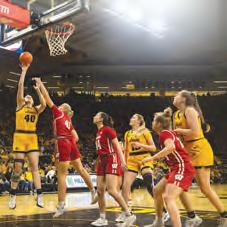UI student cheats the system with ChatGPT
A University of Iowa student used the artificial intelligence program to write a paper — and got an A.
Cooper Worth News EditorGetting an A on a paper was easier than one University of Iowa student thought.
The UI student — who was granted anonymity by The Daily Iowan — said they had a successful history of cheating on assignments in high school. When they heard about the artificial intelligence program ChatGPT last year, they were immediately intrigued. Chatbots are designed to answer frequently asked questions; provide information, assistance, and customer service; or even entertain the user.
The platform can explain complex topics like Albert Einstein’s theory of relativity, write an original song about the causes of the U.S. Civil War from the perspective of rap artist Lil Baby, and do everything in between — all in a matter of seconds.
The software was created by the Elon Musk-backed AI company OpenAI and was released free to the public in November 2022. By January, the platform reached 100 million users.
Like many UI students, the student who cheated with ChatGPT felt overwhelmed with the workload they had to complete for their classes. They claimed they received the prompt for a class paper a week before it was due.
“I was just scavenging through notes, lecture slides, the internet, trying to find whatever, and it was just such a hassle,” they said. “I was in a pickle at this time because I had other [school work] to worry about, and I was like, ‘I don’t have time to do this.’”
During this time, the student started hearing about a website that writes papers free of charge from friends around campus. The student said they had always been aware of AI services, but none as complex as ChatGPT.

“I was just like, ‘There’s no way [ChatGPT] is possible.
I was in a pickle at this time because I had other [school work] to worry about, and I was like, ‘I don’t have time to do this.’ ”
— A UI student who used ChatGPT to cheat
There’s no way this is a thing,’” they said.
The student said they were introduced to the service by a friend on campus who used ChatGPT to complete an assignment.
“I was like, ‘Well, if [ChatGPT] gave him answers for this business class, I can 100 percent plug in a random era that happened in our history,’” the student said.
The student typed the paper’s prompt into ChatGPT CHATGPT | Page 2
UI sees trend in faculty resignations
Kate Perez News EditorFaculty resignations are increasing at the University of Iowa.
From fiscal 2021 to fiscal 2022, UI faculty resignations rose from 80 to 92, according to the state Board of Regents’ Annual Human Resources Report. The number has been climbing since fiscal 2020, when there were 73 resignations recorded.

Faculty resignations are also climbing at Iowa State University and the University of Northern Iowa. The number of faculty resignations at ISU increased from 36 to 44 while faculty resignations at UNI more than doubled from 10 to 21.
Overall, faculty resigna-

tions at regent universities increased from 126 to 157 in fiscal 2021.
Faculty resignations at the UI are reflected in the recent 2022 Campus Climate Survey, where over half of faculty, staff, and postdoctoral students said they considered leaving the university from 2021-22. Faculty, staff, and postdoctoral students reported that they considered leaving for a variety of reasons:
• Sixty two percent of respondents considered leaving because of better salaries or compensation at another institution.
• Fifty nine percent of respondents consid-

UI reports decreased faculty satisfaction with DEI
The majority of the survey’s findings are consistent with recent years.
Archie Wagner News ReporterSome University of Iowa faculty are dissatisfied with the way the university is handling diversity, equity, and inclusion efforts.


In two questions on the 2022 UI Campus Climate survey, 27 percent of faculty and staff agreed that attention to DEI distracts from academic goals and achieving the university’s mission. Additionally, 36 percent said there is too
much emphasis put on DEI issues.
The 2022 UI Campus Climate Survey, an online survey that is conducted every two years, is sent to students and staff in the spring semester.
Overall, 83 percent, or 4,731 faculty and staff members, responded that DEI is important to them.
Elizabeth Tovar, UI Division of Diversity, Equity, and Inclusion executive officer and associate vice president, said the 2022 survey’s results
were consistent with past surveys.
In 2018, the survey found 86 percent of responders generally agreed that the UI overall had a strong commitment to DEI. Seventy-five percent of faculty, 89 percent of staff, and 87 percent professional students also agreed that the UI is committed to DEI initiatives.
Tovar said the survey gives campus leaders areas to focus on, such as faculty, staff, and em -
ployee retention.
“We also know that one of the top three answers that people give [for leaving] has to do with workplace culture,” Tovar said.
Tovar said the UI defines DEI in the broadest terms possible to emphasize inclusivity and belonging. DEI is not only about race or gender, but also accessibility and providing students the tools they need to be successful, she said.
“The vast majority of individuals who hold
Ph.D.’s in STEM fields are white, and then a very small percentage of them come from underrepresented populations,” Tovar said. “So, we need to make sure that we do a better job of recruiting individuals who want to go into those fields and helping them get jobs in those fields.”
Tovar said DEI initiatives can be hard to tackle because it revolves around people’s
The state Board of Regents reported an increase at all of Iowa’s public universities since 2020.
and was given the answer they needed for the paper.
“All I did was plug in the question, and it was perfect,” they said.
The DI tested the prompt in ChatGPT and received a 400-word paper in under three minutes. After prompting the AI further, the DI was able to get the AI-written work to be closer to 1,000 words to fit the likely parameters of the assignment and to broaden the focus of the paper. This all took about 10 minutes.
Initially hesitant to turn in their AI-assisted paper, the student altered some of the text to be extra careful and ran the text through Google.
“I tried every single sentence, like copied it, put it in Google to see if it’ll be somehow traced back to [ChatGPT], and it’s just untraceable,” they said. “But I still had doubts because I just risked my academic promise over some stupid [paper].”
ChatGPT pulls information from 570 gigabytes of data obtained from articles, books, Wikipedia pages, and other pieces of writing on the internet.
According to ChatGPT’s homepage, the service has limited knowledge of world events after 2021.
Despite their concerns, the student turned in the paper that ChatGPT produced. They thought it had been detected, as the professor took longer than expected to grade their paper.
Finally, the student recieved an email informing them that their essay was graded. The grade? It was an A. “I’m still blown away … even the ICON accuracy test [showed] it was perfect,” they said. UI’s response to use of ChatGPT
Since ChatGPT was released to the masses late in the fall semester, the UI has offered a few ways to support professors.
In January, the Office of Teaching, Learning, & Technology released a guide offering instructors tips on how to talk with students about AI services.
“The newest entry in a long line of technologies that promise to disrupt higher education are artificial intelligence (AI) tools like ChatGPT,” ITS’ website stated. “Iowa students are likely to engage with these tools, and it is clear that instructors will need to consider carefully how to adapt.”
The website includes a tab that provides guidance to UI staff on how they can detect text generated by ChatGPT using platforms like GPTZero and Turnitin. Some UI professors already use these programs to review online assignment submissions.
Over 6,000 instructors from universities like Harvard and Yale have used GPTZero since its release.
Officials at Iowa State University composed a task force to study ChatGPT and other AI tools. Meanwhile, Rutgers University has left it up to professors to decide whether or not to ban AI tools or allow students to incorporate it in their assignments.
The two largest school systems in the U.S. — the Los Angeles Unified School District and the New York
The Daily Iowan

City Department of Education — already blocked the use of ChatGPT on school Wi-Fi because of plagiarism concerns and the chatbot’s accuracy.
After gaining national media attention following ChatGPT’s release, Charles Keene, UI Tippie College of Business associate dean for undergraduate programs and professor of instruction, said he first became familiar with the platform from his son who is a current high school senior.
“If people are using a tool like this to cheat, then they are not learning those fundamental building blocks that will be important to do a more elaborate, you know, essay or presentation,” Tully said. “Skipping the basics could be something that could be damaging if it becomes a widespread practice.”
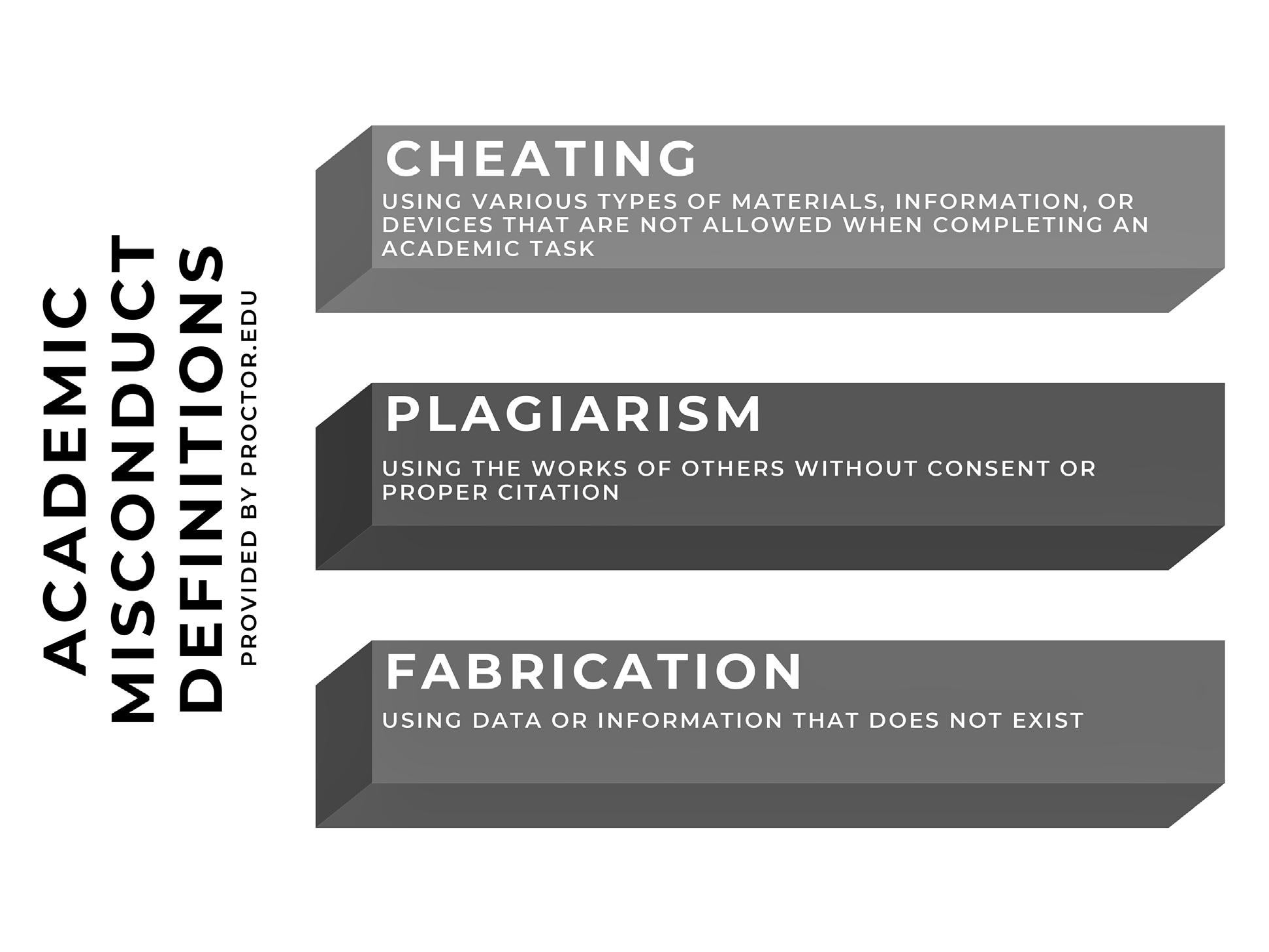



—

Keene said his son showed him how the chatbot works and informed him that many friends his age use the platform.
Keene said it is too early for members of academia to ban ChatGPT because it would be counterproductive for future college students.
“I always think through the lens, like, if we’ve got high school students already becoming familiar with this and comfortable with it, and then they come to us, and we say, ‘You can’t use that.’ Well, they’ve been learning this,” Keene said. “It’s a part of their environment.”
Keene said ChatGPT is just the latest progression in the evolution of education technology.
“Eighty years ago, we were hand calculating everything in a statistics class, and then comes punch cards, and then along comes discs,” he said. “It’s like saying, ‘Class, we’re gonna take out our abacus today calculator?” well how about a calculator.”
Melissa Tully, the UI School of Journalism and Mass Communication interim director, said chatbot services pose a legitimate concern regarding students cheating.
As much as skeptics of ChatGPT want to liken it to the evil supercomputer HAL 9000 from the film “‘2001: A Space Odyssey,” the service does have its limitations.
According to the platform itself, ChatGPT may have inherent biases in its training data and also lacks:
• Emotional intelligence Contextual understanding of topics
• Creative problem-solving skills

Loren Glass, UI English department chair, experimented with ChatGPT and said the chatbot gives generic answers.
“I did give it a test run on some paper assignments and had some interesting discussions with colleagues about whether the resulting papers would be a B or a C, but that’s only when you give it generic questions,” Glass said.
He had it compare and contrast books and said it might get a decent grade particularly if a student turned it in for a large class and if someone tried to edit it afterward.
Glass said he immediately realized he was going to have to adapt and change some of the ways he designs class assignments.
“I used to make general paper assignments
because I wanted the students to come up with their own topics, but I think now I’m going to have to do more specification to make sure that people don’t find ways to run it through [ChatGPT],” he said.
Some members of the UI English department think assignments should now be tailored to the classroom experience, Glass said. Other faculty members are trying to find ways to incorporate AI into their teaching, he said.
“Everyone acknowledges that this is a changed reality not just for teaching English, but for the culture,” he said. “But people are not in a panic about it. They’re finding ways to adapt to it.”
An AI revolution AI chatbots like ChatGPT aren’t going anywhere. Most major technology companies are launching their own versions of the program:
• OpenAI is expected to release an updated version tool, ChatGPT 4, which is better at generating text than previous versions.
• Google recently unveiled a beta version of their rival chatbot, BardAI.
• Microsoft plans on investing $10 billion into OpenAI and announced that its search engine, Bing, is being revamped to incorporate AI to help generate user search results.
• Shares for the digital media company BuzzFeed doubled in January after the company announced plans to use ChatGPT to help produce quizzes and other content.
Keene said there is potential for AI to create new jobs for students.
“When I think about something like ChatGPT, and you ask it to write something up, and it writes it up, well, who’s going to translate that and give it context?”
Keene said. “Who’s going to tell somebody how and
why it said that?”
Tully said members of the UI School of Journalism will participate in a workshop conducted by the Office of Teaching, Learning, & Technology about ChatGPT and the inner workings of AI services in March. The student who cheated said they would potentially use ChatGPT again but had doubts about how long it will remain available for students.
“I know it’s gonna get [shut] down. I hope [the UI] doesn’t respond to it because there are more things they should worry about,” they said. “I’d much rather learn at least the majority of the [material] rather than just, like, cheat my way out.”
Editor’s Note: Melissa Tully is a member of the Student Publications, Inc. Board.
cooper-worth@uiowa.edu
I’d much rather learn at least the majority of the [material] rather than just, like, cheat my way out.”A UI student who used ChatGPT to cheat
Iowa Democrats navigate new future
Emily Delgado Politics ReporterAfter the Democratic National Committee approved a new primary calendar for the presidential nomination process, Iowa Democrats must navigate a new future without their firstin-the-nation spot and the attention, donations, and organizing that come with it.

Iowa Democrats, which have a new party chair at the helm, are now focusing their fight on winning elections in the swing state that experienced a red wave in last year’s midterm elections. But they face an uphill battle after Republicans swept almost every branch of the Iowa government and Iowa’s congressional delegation.
Democrats rearrange the calendar, Iowa loses its spot in the early window
The new calendar has replaced Iowa with South Carolina as the state to lead the 2024 presidential primary elections.
In June 2022, Iowa Democratic leaders spoke at the Democratic National Convention
Rules and Bylaws Committee meeting and proposed changes to make the Iowa caucus more productive, including implementing a primary ballot and mailin or drop-off voting.
Despite Iowa Democratic leaders’ efforts to keep Iowa as the leading state in the presidential primary process, the DNC voted in January to move forward with the new calendar.
Ed Cranston, the chair of Johnson County Democrats, said many Iowa Democrats were disappointed after changes to the party’s primary didn’t sway the vote.
Despite the DNC calendar, Iowa still has a chance to hold its first-inthe-nation status, Iowa State University Political Science Professor Steffen Schmidt said. He said Iowa state law dictates Democrats must hold a county political convention before any other state. However, Iowa Democrats will likely have to wait until Super Tuesday to pick their presidential hopeful. Iowa law states that Iowa’s political parties must have a county political convention
before any other state, not presidential preference votes. Schmidt said some other states are also unable to change their state primary laws.
Georgia’s Republican leaders and New Hampshire’s laws block efforts to move the calendar forward. Both states missed deadlines to make changes to their state’s primary elections.
National Democrats’ main argument against keeping Iowa’s first-inthe-nation status include the lack of racial and ethnic diversity among Iowa voters, especially with the state’s large share of rural voters.
With the new calendar starting in South Carolina and ending in New Hampshire, the Midwest voter population is not represented, Cranston said.
Republicans already seized on the change to share a message that Democrats are overlooking Midwestern voters.
“They’re giving middle America the middle finger,” Sen. Joni Ernst, R-Iowa, tweeted on Feb 4.
Despite the DNC’s changes, Iowa held onto its leading nomination
spot in the Republican National Committee calendar.
“The DNC has decided to break a half century precedent and cause chaos by altering their primary process and ultimately abandoning millions of Americans in Iowa and New Hampshire,” RNC Chairwoman Ronna McDaniel said in a statement.
In the 2020 election cycle, President Biden won in South Carolina primary but lost in Iowa.
Schmidt said the new calendar is a sign of Biden’s dislike for the Iowa caucuses, which indicates conflict between Biden and the DNC. Biden has not officially announced whether he’ll seek reelection for president in 2024.
The future for the Iowa Democrats
Former Iowa state Sen. Rita Hart was voted to serve as the new Iowa Democratic Party chair. Hart came into the role after the party suffered major losses in the November midterms.
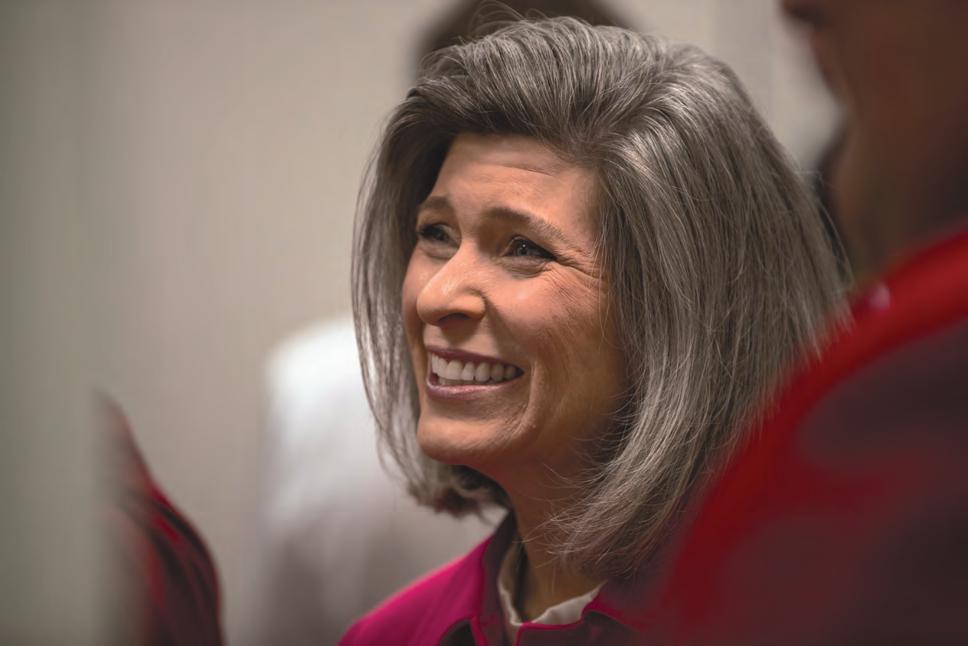

“As I have explored taking on this role as chair in the last month, I have been clear from the

very beginning that we need a team approach for Iowa Democrats to start winning elections again. Everyone has a part to play,” Hart said in a news conference.
Hart said her main goal as party chair is to increase the number of Democrats elected to office.
“I think it is so important that we are working together for Iowa’s best interest,” Hart said. “... I think this is one of the places where Republicans and Democrats are working together, and I appreciate that.”
Senate Minority Leader Zach Wahls, a Democrat from Coralville, said Hart’s enthusiasm to get more Democrats in office is what the party needs.
Schmidt said Democrats have no leverage in the Iowa Legislature, which he said explains the number of conservative bills being passed in the current session.
Notably, there was a stalemate last year in the Legislature over Gov. Kim Reynolds’ proposal to divert taxpayer dollars toward private school tuition assistance. But this year, the bill quickly sailed through the 2023 Legislature as the GOP expanded its majority.
The new calendar is only for the next election.
If Hart is successful, Linn County Democratic Party Chair Bret Nilles said Iowa has potential to
Nikša Poleksić said he hopes the calendar is a motivation for the Iowa Democratic Party to take campaigning more seriously.
“I think it just comes down to finding better methods of campaigning and organizing,” Poleksić said.
The legacy of the Iowa Caucus
Nilles said the Iowa caucuses are ideal for sorting out the stronger candidates within the party. The caucuses have been crucial in determining the outcome of the 2000-16 presidential elections, according to The New York Times.
Although Biden did not win Iowa during the 2020 election cycle, the Iowa caucuses played a major role in the election of former President Barack Obama.
“If it hadn’t been for him winning the Iowa caucuses, he would never have gotten the nomination and never have become president,” Schmidt said.
The removal of Iowa from the top of the presidential nomination process means Iowans will not have easy access to Democratic presidential candidates.
Poleksić said he doesn’t see Iowans getting a high level of access to national candidates because of the calendar change.
“I don’t foresee it having great effects,” he emily-delgado@uiowa.edu
In 1976, former president Jimmy Carter won the first Democratic caucus that was held in Iowa.

After being bumped from first-in-the-nation status, Iowa Democrats look to regain ground in the state.Gabby Drees/The Daily Iowan Former Iowa state senator Rita Hart speaks at a campaign event for democratic candidates Liz Mathis and Christina Bohannan at the Sutliff Farm & Cider House in Lisbon, Iowa, on Sept. 9, 2022. Hart represented the 49th Congressional District from 2013 to 2019. Hart lost to current U.S. House Representative Mariannette Miller-Meeks by six votes in 2020. Gabby Drees/The Daily Iowan Sen. Joni Ernst, R-Iowa, talks with constituents at an early morning meeting in the Hart Senate Office Building in Washington, D.C. on April 6, 2022. Ernst tweeted about the new calendar regarding the Midwest. Evan Weidl Opinions Columnist

The possibility of bringing back child labor should be out of the question. But in Iowa, it is now a real threat. Iowa is considering loosening laws on child labor to combat the shortage of workers. The bill has already moved out of a subcommittee and continues to make its way through the state legislative process.
It is one problem that the state is considering loosening these laws. It is another problem that this is our solution to a worker shortage. The state should not be willing to put children in danger in lieu of improving conditions for workers.
The bill would include changes such as allowing 14-year-olds to work in freezers and meat coolers, laundry, and corn detasseling.
There is no doubt that labor is harmful to children.
According to the National Library of Medicine, child
Opinions No to child labor
Instead, we need to treat workers with more dignity.
labor “prevents the normal well-being including physical, intellectual, and emotional psychosocial development of children.”
Lawmakers argued that letting children work in these dangerous conditions will give them a chance to learn life lessons. While this bill is really about boosting the economy without having to treat workers better, a child does not have to do manual labor to learn important life lessons.
While supporters of the bill argue joining the workforce will give children experience that will prepare them for future careers, experts say the jobs offer skills that are not transferable, and the experience is trivial.
The bill could also lead to the loosening of more child labor laws. Peter Hird of the American Federation of Labor said in a Cedar Rapids Gazette Feb. 14 article, “We’re not that far away from dozens of children working in a factory assembling parts.” Even if all of the law changes didn’t directly cause significant harm to children, it is absurd that the state is more willing to put children to work than they are to treat their current workers better. There are plenty of solutions to
the current labor shortage that don’t require us to let teenagers work in meatpacking plants.
One solution is raising wages. Iowa’s minimum wage is just $7.25 an hour. This is a starvation wage and is not nearly enough for a worker to live on. A fulltime employee in Iowa must
make at least $15 an hour to be able to afford a “modest” two-bedroom apartment without spending more than 30 percent of their income on rent. While some may want to blame the worker shortage on laziness or claim people just don’t want to work these days, they are
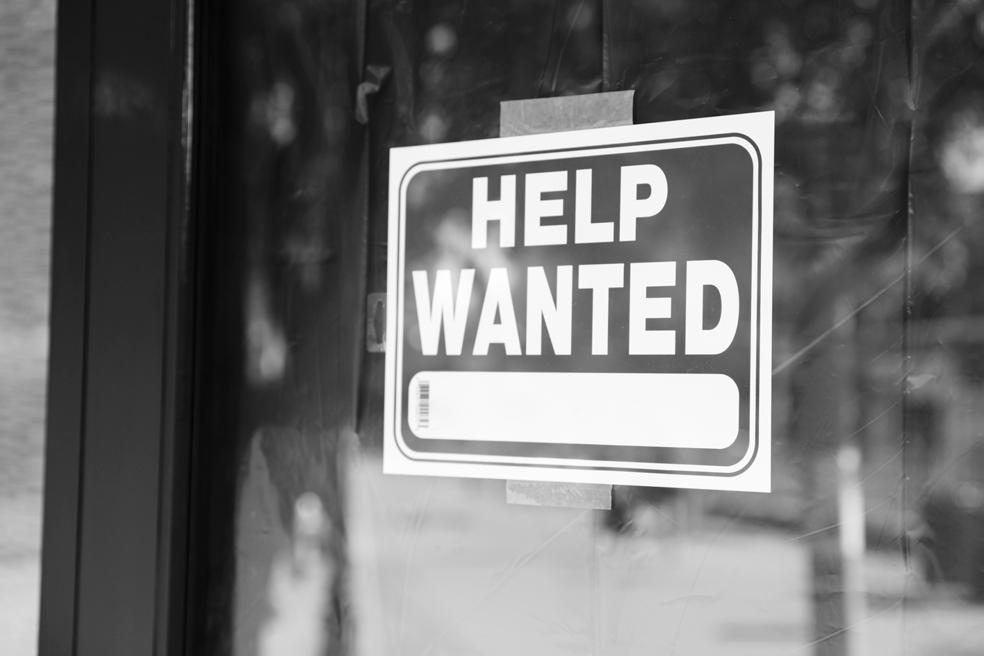
mistaken. Workers simply want dignity — fair wages, good conditions, and respect from their employers.
Employers across the country ended their staff shortages simply by boosting starting pay. It’s not rocket science; people want money. Give it to
Why co-housing?
them, and they will want to work for you.
Ultimately, Iowa lawmakers must reject this bill and examine the real causes of this labor shortage and pass bills that give the workers the respect and treatment they deserve.
evan-weidl@uiowa.edu

Prairie Hill points us toward a future that is not only environmentally friendly but encourages a healthy social life.
style. Dorm life has its benefits, but the concept of co-housing communities offers an eco-friendly and supportive lifestyle that Iowans should embrace.
Chris Klepach Opinions ColumnistImagine walking down your street and being greeted by your closest friends.
Living in Prairie Hill, a co-housing community in Iowa City, is not far from this dream. This co-housing community can point toward a solution for the isolation many Iowans have felt while developing a sustainable life-
Prairie Hill, which sits at 140 Prarie Hill Lane, is in walking and biking distance of restaurants and a few blocks south from west-side student living.
Move-ins started in 2018 and the community has flourished ever since.
It is a multigenerational community home to 37 residencies receiving visitors from near and far. Every co-housing residency includes a common house. Prairie Hill’s
common house is where residents can gather for meetings, cook and bake in the kitchen, and engage in recreational activities at the activity room. It also includes two guest rooms, a laundry room, and mailboxes.
As a community, Prairie Hill is dedicated to an eco-friendly lifestyle that encourages members to adopt small spaces of land at the garden. Homes incorporate solar panels and efficiently designed infrastructure to minimize resource waste. In turn, residents see lower utility payments than normal housing arrangements. Del Holland and Bar-
bara Bailey, members of Prairie Hill’s Board of Managers, said Prarie Hill gives their members a strong sense of community.
“When you walk out the door to go get your mail, or to get to your car, or your bicycle, you almost always run into your neighbors doing a similar thing,” Holland said. “Then you end up talking about whatever — The weather, the politics. And that’s something I didn’t have in the neighborhoods I lived in Iowa City before.” Bailey said Prairie Hill residents create opportunities to get together.
“There’s a lot of reci-
procity when people do things for each other, and we learn about the things that need doing by getting together and talking to each other,” Bailey said.
Co-housing is a promising light in a city where, frankly, living space can be expensive, isolating, and unfriendly to residents. As we move further from the mental and social blockages caused by the COVID-19 pandemic, we need to look toward housing models like Prairie Hill that encourage strong communities.
As one of the few seniors who still lives in the University of Iowa dorms, I can attest that there is a
I believe in ‘Iowa nice’
good community that can come from the dorm experience. But some students may find difficulty in getting to know their dorm neighbors.
Prairie Hill is designed to foster interactions with neighbors. The idea of gathering at the common house to chit-chat about life has an allure unlike any other living situation.
Co-housing communities offer an ecologically balanced way of living that comes with the added benefits of having a good friend live close to you — a living arrangement I relish.
christopher-klepach@uiowa.edu
“Iowa nice” is a twoword slogan that I have had to learn and adapt to since I started living in Iowa.
The term has become controversial, particularly during these times filled with social activism in response to hate and discrimination.
Despite what many have said in recent years, I believe Iowa nice is real. Coming here from my home state of California, I
wasn’t sure exactly what to expect from Iowa or its people. I was surprised to learn that the state possesses an endearing term for its people’s attitude. Less surprising to me, the state did not have an endearing term to describe Californians. My experiences with Iowans have led me to the conclusion that Iowans — like Californians and all other people I have encountered — are a mixed bag. This similarity that connects these otherwise seemingly distant groups is what drives my stance on Iowa nice.
As implied, Iowa nice is meant to define friendly and helpful attitudes presented by Iowa residents. While its exact origins are unclear, Iowa nice is an
adaptation of “Minnesota nice” that likely gained popularity between 194851 — a time when the state was recognized for its progressive ideals.
The term has been covered in Iowan publications like the Cedar Rapids Gazette and the Quad City Times as well as national publications such as Huffpost and Vice.
The consensus among articles covering the term is that Iowa nice is a myth. It is a cultural label made for marketing and political purposes. While many of these articles tackle the terminology from a sociopolitical perspective in response to racism and discrimination in Iowa, I have chosen to view the term from a broader
perspective that encompasses my experiences socializing with people from around the world without denying the existence of racism in the state.
First, the definition of Iowa nice does not differ greatly from the definition of nice. The words hold synonymous meanings, with the only difference being that Iowa nice pertains specifically to Iowa, thus implying that Iowans are nicer than their neighbors or people from other parts of the country. What makes this complicated is that niceness cannot be measured, nor can it be given a single definition that every individual can agree upon. Perspective is the greatest measure of niceness.
A white Iowan may find it nice that another Iowan fixes their tires. A Black Iowan may find it nice that another Iowan is supporting their business. This same concept can be applied to any part of the world.
Another worldwide concept displayed in Iowa nice is regional pride. By no means do I think Iowa is the greatest place in the world, but who would tell that to someone who has lived here their whole life? Other examples of regionally biased cultural labels include the aforementioned Minnesota nice, “Nebraska nice,” and “Southern hospitality.”
A common argument against Iowa nice is the existence of some not-so-
nice statistics, such as the fact that Black Iowans are 11 times more likely to be incarcerated than white Iowans. While I do not dismiss this, racism is a nationwide epidemic not exclusive to Iowa, and every place has its own notorious statistics they are not proud of.
With these commonalities between Iowa and the outside world, how greatly does Iowa nice differ from regular nice? Why can’t Iowa nice simply be defined as a nice person from Iowa?
In a time where negativity is abundant, and with niceness being subjective and constant around the world, Iowa nice is real to me.
EDITORIAL POLICY STAFF
Hannah Pinski, Executive Editor Sophia
THE DAILY IOWAN which has been serving the University of Iowa, Johnson County, and state of Iowa communities for over 150 years, is committed to fair and accurate coverage of events and issues concerning these areas. The DI is committed to correctly representing the communities it serves, especially those most underrepresented or marginalized. The DI welcomes any input on how our coverage can be improved to better serve our audience.
LETTERS TO THE EDITOR may be submitted via email to daily-iowan@uiowa.edu (as text, not attachments). Each letter must be signed and include an address and phone number for verification. Letters should not exceed 300 words and may be edited for clarity, length, and style.
gabriel-arboleda@uiowa.edu

GUEST OPINIONS must be arranged with the Opinions Editor at least three days prior to the desired date of publication. Guest opinions are selected and edited in accordance with length, subject relevance, and space considerations. The DI will only publish one submission per author per month. No advertisements or mass mailings, please.
READER COMMENTS that may appear were originally posted on dailyiowan.com or on the DI’s social media platforms in response to published material. Comments will be chosen for print publication when they are deemed to forward public discussion. They may be edited for length and style.
ered leaving because of primary workplace climate/culture and 26 percent because of the campus climate/culture.
• Seventy five percent of respondents reported bias at the university caused them to consider leaving.
The regents report also detailed the average salary amount at the UI increased steadily for faculty, postdoctoral and scientific employees, and merit employees since fiscal 2018. For faculty at the UI, the average salary increased from $116,581 in fiscal 2022 to $121,818 in fiscal 2023.
Salary and pay amounts have lately been a topic at the UI, as the university’s Campaign to Organize Graduate Students recently met with the
regents to request a 10 percent salary increase on Feb. 16. COGS conducted multiple campaigns and protests to advocate for better pay as graduate workers at the university, including picketing on the Pentacrest and gathering outside of UI President Barbara Wilson’s office.
The organization isn’t only advocating for wage increases. At the meeting with the regents, COGS requested 12 weeks of parental leave, access to free parking and/or reimbursement of parking and/or bus fees, and access to safe working conditions and personal protective equipment.
Additionally, COGS requested they add a deadline for reappointment letters and an option to work 20-25 days remotely at the university.
The organization is set to meet with the regents to continue negotiating
both wages and other benefits proposed on Feb. 27 in a closed session meeting.
Additionally, retention and recruitment is a key goal listed throughout the UI’s 2022-27 Strategic Plan, which began implementation last year.
The ideas reflecting retention and recruiting in the UI’s strategic plan include using practices and data-driven, evidence-based procedures to retain exceptional
students, faculty, and staff. Additionally, the plan places emphasis on discovering what is making students, faculty, and staff leave the UI.
Combating resignations of faculty and staff through professional development, recognition, and a culture of connection and employee value is a top goal outlined in the university’s strategic plan.
Since 2019, the university launched multiple
thoughts, feelings, and belief systems, and the UI does not want to change those systems for people.
Loren Glass, UI English department chair, said he has not seen any aggression toward DEI initiatives but rather passive resistance.
In 2020, Glass set up a committee called Ideas for Inclusion, Diversity, and Equity Access and Social Justice in response to student demands. Glass said it was the first standing committee in the English department to include undergraduate and graduate students and staff.
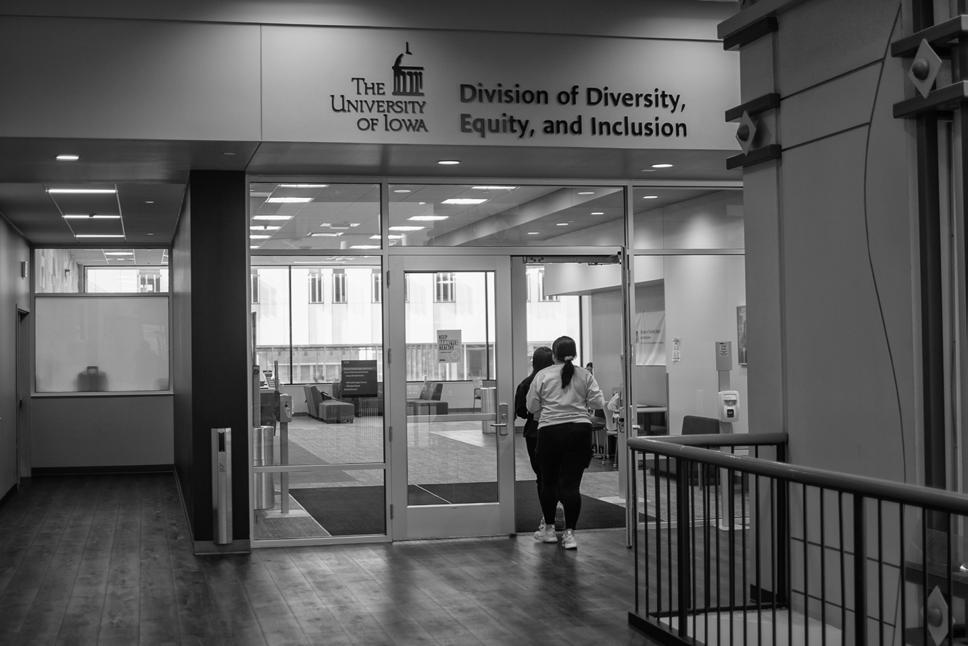
“We had some concerns from students of color and allied students — both undergrads and graduate students — about a num-
ber of issues regarding the culture and climate of the English department,” Glass said.
Glass said because the committee was voluntary, there were some faculty who didn’t want to participate.
“I think some folks think they’re already ‘woke’ and have already done what they need to do and don’t need a committee to tell them what to do,” Glass said. “There are some people who associate that kind of work with the kind of corporate diversity culture, you know the kind of ‘Disneyfication’ of diversity, and so they don’t like that either.”

Glass said some students are busy with their own lives and are not aware of how much the issue of diversity at the UI needs to be addressed.
“I will say that the most
important thing though really is recruitment and retention of faculty, staff, and students of color, to make sure that we don’t have a tokenism situation,” Glass said. “I don’t want to have one representative faculty of color. I want to have a community of people of color.”
Sarah Vigmostad, in-
terim associate dean for Diversity, Equity, and Inclusion for the College of Engineering, said faculty reactions to DEI have been positive.
“I would say that our faculty are very supportive and enthusiastic about sort of using research-backed best practices to advance DEI to
foster an inclusive classroom environment,” Vigmostad said.
For faculty engagement in DEI, Vigmostad said the College of Engineering has been focusing on classroom practices and policies for inclusion and including discussions on social responsibility in the curriculum.
programs geared toward recruiting and retaining exceptional faculty, including the High Impact Hiring Initiative, the Transformational Faculty Hiring Program, and the Iowa Faculty Scholar Award.
The regents will receive the Annual Human Resources Report at its upcoming meeting on Feb. 22. katharine-perez@uiowa.edu
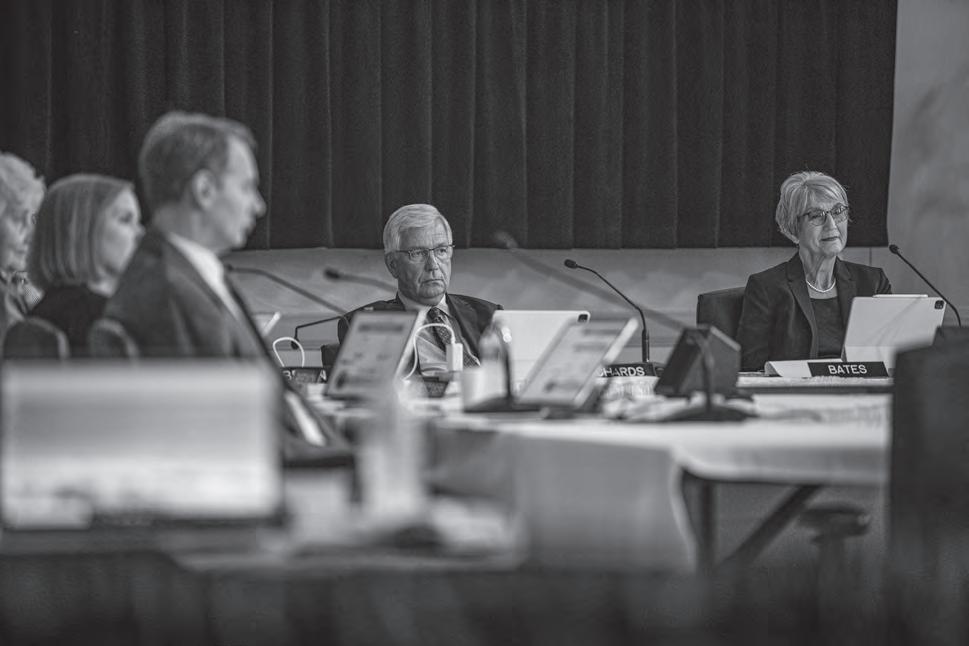
Across


“Engineering, even though it’s a very technical field, it also is a field that has a direct impact on society,” she said. “And so, recognizing and integrating those discussions, I think there’s opportunities where we can be doing that better.”
archie-wagner@uiowa.edu

UI cancer research inspired by latte foam
Researchers at the UI used biocompatible materials inspired by culinary techniques to improve the effectiveness of chemotherapy and radiation for treating cancers in mice.
Sofia Mamakos News ReporterResearchers at the University of Iowa found inspiration from the same bubbly foam found on a morning latte to improve the effectiveness of cancer treatments.
In a new study published Feb. 2 in the journal Advanced Science, researchers used gas entrapping materials, which are materials they designed to carry high concentrations of gasses directly into tissues and tumors and can be formed as foams, solids, or hydrogels, to enhance therapies and slow tumor growth in mice.
Leo Otterbein, a contributor of the research from Beth Israel Deaconess Medical Center in Boston, said the techniques used in the study were a relatively uncomplicated process.
“It’s such a simple concept that you can put gas into these foams, and the foams themselves are things that you’d find in restaurants or in the grocery store,” Otterbein said.
The researchers reverse-engineered a whipping siphon — a device commonly used by baristas to create foam with nitrous oxide — to construct the foam gas entrapping materials with oxygen instead.
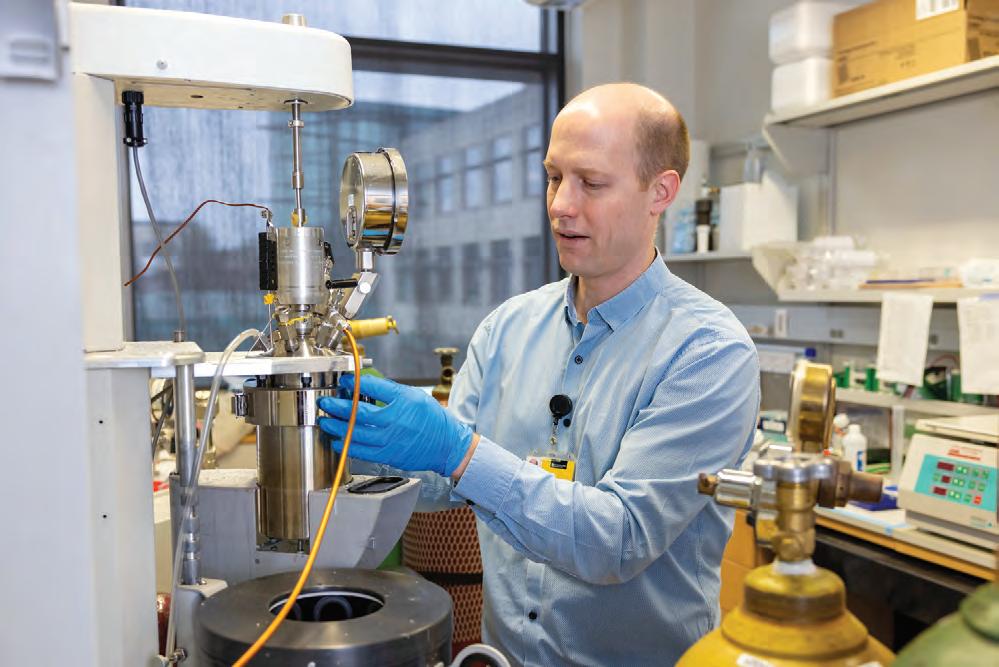

James Byrne, UI assistant professor of radiation oncology and senior author of the study, said it consisted of creating a new, unique material
based on the intersection and conversions of the field of medicine and the culinary arts.
“These are really simple, really safe materials that you can actually find within lots of foods and various pharmaceuticals, and so they’re very, very translational,” he said.

Translational is a word used to describe methods that easily can be converted from mice model testing to research on humans.
Researchers tested the material on prostate cancer and types of sarcoma in mouse models. They found that when combined with radiation and chemotherapy, the materials they implanted had a huge effect in slowing tumor growth.
“We saw profound slowing of tumor growth within two different animal models of cancer,” Byrne said. “Not only that, we also saw a change within the tumor environment.”
Byrne said cancer oncology treatments have recently focused on looking at the tumor microenvironment.
“We know these tumors are very hypoxic, which means that they have low oxygen levels,” Byrne said.

“That infiltrates really every part of cancer and cancer therapies. We saw that by just having more oxygen there, we were changing that environment to make it more conducive and responsive to even immunotherapies.”
Otterbein agreed that, along with therapy, add-


ing oxygen in this way can help eliminate the tumors.
“By injecting this into tumors, he provides a benefit by essentially creating a tumor that is usually hypoxic or low oxygen, and he gives it a burst of oxygen that normally doesn’t see,” Otterbein said. “That’s a benefit to the body by helping eliminate the tumor, and you combine that with radiation, and you get an even better effect.”
Emily Witt, a contributing author of the study, wrote in an email to The Daily Iowan that the research aimed to increase oxygen levels in cancerous tumors to someday have a positive impact on patient outcomes.
“We found that injecting or implanting the [gas entrapping materials] into tumors can mitigate tumor hypoxia by delivering oxygen locally,” Witt wrote.
Byrne said the GeMs
were able to enhance responsiveness to radiation and chemotherapy in multiple tumor types and improve the management of tumors that are treatment-resistant in standard therapies.
“There are some really non-responsive tumors out there that continue to grow despite being on maximal therapies, and so we thought that we could provide a big benefit there,” he said.
Because the study is only preclinical, the next step in this research is to create a safe and deliverable material to human patients.
“I want to see this trend translated to patient care,” Byrne said. “Again, these are very, very translational materials that I think would be a nice fit and, hopefully, easy to move into clinical trials.”
sofia-mamakos@uiowa.edu
JoCo uses ARPA to fund language accessibility



The program is releasing surveys to gauge the needs of non-English speakers in the county.
services for translations.

 Alejandro Rojas News Reporter
Alejandro Rojas News Reporter
Non-English speakers in Johnson County will soon have access to a county services program that will address gaps in foreign language translation, it was announced on Feb. 15 in the Johnson County Administration Building.
The program is in the preparation phase, and surveys will be released to first identify what the needs of the county are regarding language translation accessibility.
It will address gaps in the county’s ability to serve non-English speaking populations by implementing tools and policies to assist departments. The county is currently unsure of what tools or policies it will use, but it will become clearer as more work is done.
The county currently does not have programs or tools to address language accessibility needs for its services. County workers interacting with non-English speaking populations rely on workers from other departments or on-demand
The county will use a framework created by the Department of Justice titled “Language Access Assessment and Planning Tool for Federally Conducted and Federally Assisted Programs,” as explained by Johnson County’s Diversity, Equity, and Inclusion department on Feb. 15.
According to presentation slides included in Wednesday’s meeting, the county is working on the first part of the framework, conducting a self-assessment to gauge where the county is currently.
This will take on the form of surveys, Paola Jaramillo Guayara, Johnson County Diversity, Equity, and Inclusion coordinator, said.
Guayara added that the first survey was already released and was funded with $50,000 in American Rescue Plan Act money.
ARPA is a $1.9 trillion relief package intended to help U.S. communities financially harmed by the COVID-19 pandemic. Johnson County, with a population of roughly 150,000
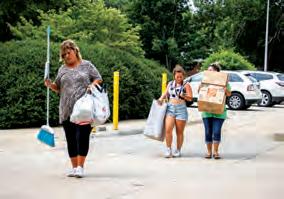
residents, received $29.3 million in 2020.
Guayara said there’s no set timeline or end date for the surveys besides the deadline to use ARPA money. This will allow the county to take its time collecting as much data as needed to ensure its next steps are well-informed.
The next phase in the framework will be the policy phase. Guayara said the policies will determine how the county directs its language access program. She also said the policies will be adjusted to fit the needs of each department.
“We have so many departments and divisions that have different means that do different things. And so, what we want to do is create opportunities so that every department gets what they need,” Guayara said. “We want to create something that really creates that standard of customer service that, regardless of where [people are] going and what they’re doing, they know exactly what opportunities are available to them.”
Guayara said many de-
partments have already been using temporary solutions to offer language accessibility.
The auditor’s office has been using an on-demand translation service that offers translators over the phone. Bailey Kelley, an elections technician for Johnson County, said her work with the community ID program sometimes meant working with ap-
plicants that do not speak English.
An important factor in the program’s rollout has been the support of the county supervisors, Guayara said.

Green-Douglass highlighted that while English may be the predominant language in the county, it was important to keep in mind the populations accessing county services
may not speak it. “We’re excited to really develop something that is going to be long-term sustaining and that allows community members to feel welcome and safe and knowledgeable when they have any sort of interaction with one of the many tentacles that Johnson County has,” Guayara said.

alejandro-rojas@uiowa.edu

MAYABB
Continued from Page 8
things, he's a very statistical type of guy. You throw out a history fact at him and he'll have a whole entire speech about it.”
Mayabb has a long history in wrestling — he’s been involved in the sport his entire life.
He competed for Central Missouri from 198083, where he was an NCAA qualifier and named the Mid-America Intercollegiate Athletics Association Most Outstanding Wrestler in 1983. He also qualified for the Olympic Trials four times in 1980, 1984, 1988, and 1992.
After graduation, Mayabb spent 32 years as a collegiate wrestling official — including 11 years as a Big Ten official from 2006-17.
His tenure as a Big Ten official provided him with multiple trips to Carver-Hawkeye Arena. He saw Iowa fans’ passion for wrestling firsthand in Iowa City, which convinced him to take a job with the Hawkeyes.
“I've also had the fortune to officiate in Carver, and when you're doing that, then you see the fans’ passion, those kinds of things,” Mayabb said. “... You can develop wrestling here at a high level because the people are already preset
KENLIN
Continued from Page 8
She needed to focus on herself instead of trying to compete in the Olym -
for it.”
During his officiating career, Mayabb also coached Missouri’s Cadet and Junior Greco national teams from 1986-2016. He also coached at two high schools in Kansas City, Oak Park and Staley, leading them to seven Missouri state team championships. Whether he’s officiating or coaching, Mayabb said the sport of wrestling always comes back to the people.
“You hopefully run into and get to travel with like-minded, hardworking individuals that are willing to cooperate and collaborate and create friendships and bonds that literally last the rest of your life,” Mayabb said. “And most of it is centered around that the work is so hard, there's no way to do it by yourself. Wrestling is perfect for that because you can't do it by yourself.”
Before joining the Hawkeyes, Mayabb didn’t have any experience coaching women's wrestlers. But he wanted to jump at the chance to join the first-ever Power Five women’s wrestling program.
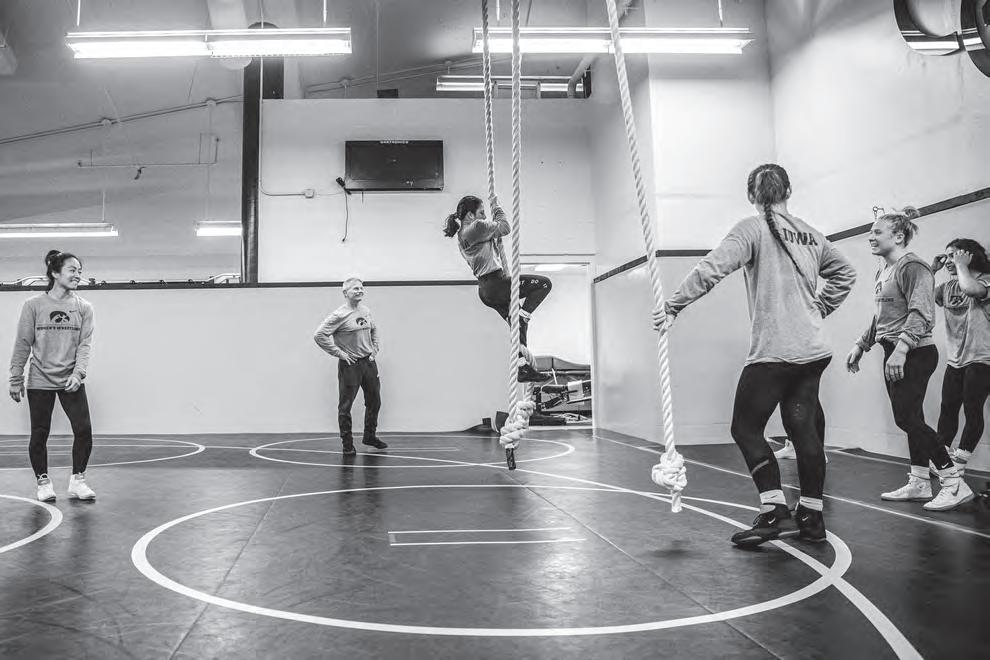
“The Chinese have a saying that ‘You live in exciting times,’” Mayabb said. “And I don't know that there's more exciting times right now in our sport of wrestling than on the women's side. There’s just so much
pics and world championships at such a young age. “It came down to injuries and my mental health at the end,” Kenlin said. “I didn't need to go to the
happening, so many things, and the sport is growing so fast.”
The Iowa women’s wrestling program will officially start competition in the 2023-24 season, but a lot of Hawkeyes — like Welker —
Olympics like everyone else wanted me to — like I wanted to — but I was like, ‘I need to do what's best for me.’”
Kenlin has still excelled at Iowa and has grown
have their sights set on the Olympics.
And Mayabb is hoping to help his wrestlers realize their vision.
“We get to talk to our athletes about a vision statement — ‘Where where
with a healthier mindset. During the 2022 NCAA Championships, Kenlin finished second to Olympic gold medalist Suni Lee, scoring a 9.95 on beam — the highest finish by an individual at the NCAA meet in Iowa history. Lee earned a 9.965.
Despite the positive culture Kenlin has found with the Hawkeyes, there are moments of struggle, which is typical for gymnasts.
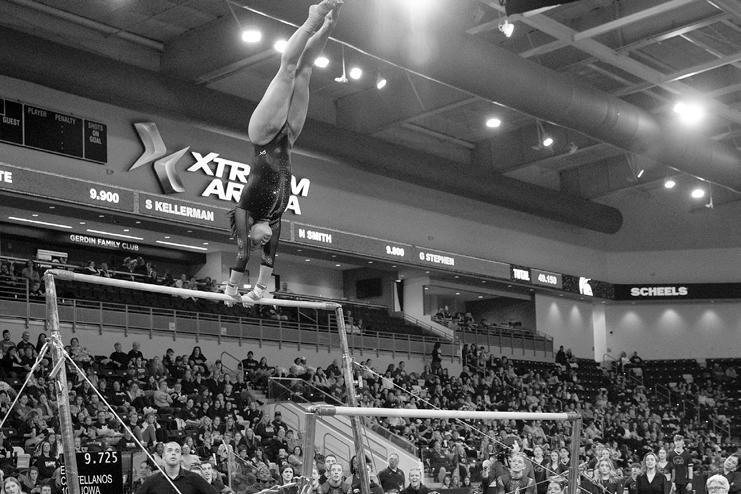
“She has her own personal demons and mental demons that she's got
do you plan on being?’”
Mayabb said. “Technically, we’re on the young side to get to Paris [in 2024]. But we could be almost at the perfect age to go to L.A. for the games there [in 2028].
But do you have the vision
to deal with in her head,” Libby said. “We all do as gymnasts.”
Libby said the most frequent issue that she sees in her gymnasts is the mental block, which is commonly known as “boxing.” Many coaches tend to use fear to get gymnasts over their mental block, but Libby said she does not believe in that method.
Rather than yelling at her athletes, Libby said she works with them in a positive way. Kenlin said she occasionally
of where you would be? … if you want to be in L.A. at the Olympic Games, that’s a pretty amazing piece of vision, and every day has to be intentional.”
chloe-peterson@uiowa.edu
faces these same mental blocks. But through positive coaching and supportive teammates, she has been able to push past those struggles.
“She puts more pressure on herself than anybody else does,” Libby said of Kenlin. “We just do our best to try and work with it and have them still leave the gym feeling like they did something to get them out of it or to move past it and hope for a better day the next day.” jami-martin-trainor@uiowa.edu
BASKETBALL
Continued from Page 8 men are typically found at the front of Iowa’s press.

With Patrick McCaffery back in the rotation, head coach Fran McCaffery and his staff have more flexibility with their defensive options, as they can run the press with Murray or Patrick McCaffery on the floor.
At a media availability session on Feb. 14, Fran McCaffery explained his reasoning for placing forwards with long wingspans at the forefront of his defense.
“A lot of teams play more of a ‘contain’ press, but we like to play aggressive and disrupt their rhythm,” Fran McCaffery said. “Having big guys at the front limits what the other team can see, and it forces turnovers, which creates offense from your defense. Both Kris and Patrick are pretty smart about when to get back on
defense and match up, and they slide their feet well.”
Fran McCaffery added that he actively pursues players that meet the aforementioned requirements when scouting potential high school recruits or transfer players.
“The way we play, we want as much length as we can have,” Fran McCaffery said. “Whether you’re playing man or zone defense, you want guys that are active and aggressive.”
Despite the statistical advantages the Hawkeyes’ press has given them since his son Patrick’s return, Fran McCaffery is aware that applying heavy pressure doesn’t always work in Iowa’s favor. “There’s always some disadvantages because you’re opening yourself up, giving them opportunities to attack you, throw it over the top, and shoot threes,” Fran McCaffery said. “That can be problematic when you play a team that plays four
guards.”
The results speak for themselves, however. In the Hawkeyes’ past five victories, they’ve scored an average of 14.2 points per game off turnovers, while their opponents average eight points off turnovers per contest. Over that same stretch, Iowa’s average margin of victory is 9.7 points. In other words: Fran’s squad is winning games thanks in part to their substantial defensive pressure.
Iowa’s players seem to enjoy the aggressive playing style, as well. Graduate senior Connor McCaffery said forcing pressure on opponents keeps the team engaged and provides energy.
“We’re aggressive with it, and it helps us force turnovers,” Connor McCaffery said. “I think we’re seeing a lot of benefits from it, and I like the energy it forces us to play with.”
grant-hall@uiowa.edu

HAWKEYE UPDATES
‘You live in exciting times’
When he got the call, associate head coach Gary Mayabb jumped at the chance to join the Iowa women’s wrestling program.
College GameDay coming to Carver-Hawkeye Arena
ESPN's College GameDay will be coming to Carver-Hawkeye Arena for the first time on Feb. 26, airing from Mediacom Court from 10-11 a.m. ahead of Iowa women's basketball's game against No. 2 Indiana.
“Our program is thrilled to be oneof-three schools selected this season to have College GameDay on our campus," head coach Lisa Bluder said in a statement. “It’s a huge honor, and we are looking forward to showcasing our program on one of the best stages.”
Iowa's game against Indiana could have major Big Ten regular-season title implications. Indiana is at the top of the conference with a 15-1 record, while Iowa is one game back at 14-2.
Andraya Carter, Rebecca Lobo, Carolyn Peck, and Holly Rowe will be commentators for the hour-long show, and Elle Duncan will host.
Gates will open at 9 a.m. for ticketed fans to watch GameDay live from Carver-Hawkeye Arena. Fans are required to fill in sections AA-B first for the show. Fans may exit and reenter the arena with the same ticket for the game following the show.
The game, which will tip off at 1 p.m. and air on ESPN, is already sold out. The Iowa ticket office said it expected high demand, along with fraudulent ticket activity, for the game. The ticket office will only provide support for tickets purchased officially through Iowa Athletics.
Chloe Peterson Sports EditorKing Jr. Day in January, he spoke to his team about King's dream and the legacy that he left.
Bluder named to Naismith
Coach of the Year watch list
Iowa women’s basketball head coach Lisa Bluder has been named to the Naismith Coach of the Year late season watch list, it was announced Wednesday.
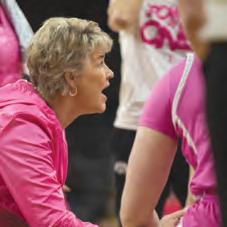
The Hawkeyes have won 20 or more games in a season for the seventh time under Bluder in 2022-23. Bluder also became the Big Ten’s alltime winningest coach in conference games this season.
The 23-year head coach also led the Hawkeyes to the highest AP Preseason Poll ranking since 1994 as the No. 4 team in the nation.
Big Ten names three baseball players to presea son honors
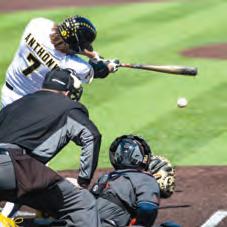
The Big Ten named junior pitchers Will Christophersen and Ty Langenberg and sophomore two-way player Keaton Anthony to its preseason honors list, the conference announced Thursday.
The Hawkeyes were also picked to finish third in the coach’s poll. Maryland was picked to finish first, while Rutgers is slated as second. Langenberg, who has been tabbed as the preseason Big Ten Pitcher of the Year by Perfect Game and D1Base ball, went 7-2 with a 3.71 ERA as Iowa’s Sunday starter. The Urbandale, Iowa, product had 74 strikeouts in 72 ⅓ in nings last season.
Christophersen came out of the bull pen for the Hawkeyes in 2022, finishing the season with a 4-2 record and 5.32 ERA.


He notched 25 strikeouts in 24 ⅔ innings.
Anthony is the reigning Big Ten Freshman of the Year and a freshman All-American selection. The two-way player hit .361 on the season with 14 home runs and 55 RBIs. Anthony only pitched two innings in the 2022 season but is slated to come out of the bullpen more often in 2023.
QUOTE OF THE DAY
“McKenna is blue-collar.”
— Iowa women’s basketball head coach Lisa Bluder on forward McKenna Warnock’s mentality. STAT OF THE DAY
2:04.28
— Iowa track and field junior Alli Bookin-Nosbisch’s record-breaking time in the 800-meter.
About once a week, Iowa women’s wrestling associate head coach Gary Mayabb gives an extended statement before the Hawkeyes begin practice. His statement is rarely about the sport of wrestling. Once, he talked about how 94 percent of female executives played a sport. Another time, on Martin Luther
“It's not always about a psychology piece or training piece, but so many times the lessons are given to us,” Mayabb said. “Not necessarily about wrestling, but again, it reflects back to what we are here for — people, the relationships that we build.”
Mayabb joined the Iowa
women’s wrestling program in May 2022 after he got a call from head coach Clarissa Chun, who asked him to apply for the job.
Chun and Mayabb worked together at USA Wrestling from 2017-21, albeit in different programs — Mayabb was the manager of greco-roman Wrestling, while Chun was the women’s national team assistant coach.
But when Chun became Iowa’s first women’s wres-
tling head coach in November 2021, she thought Mayabb would be the perfect complement to her coaching style.
“Coach Mayabb is great with culture building,” Chun said. “He has a background in sports psychology. As a stats guy, he’s very pragmatic and just so different from me that I felt like he was a great addition to this staff.”
Chun and Mayabb’s dif-
From zero to 20
After spending years practicing and performing alone, Iowa gymnastics junior Adeline Kenlin is learning to bring her best self forward for the GymHawks.
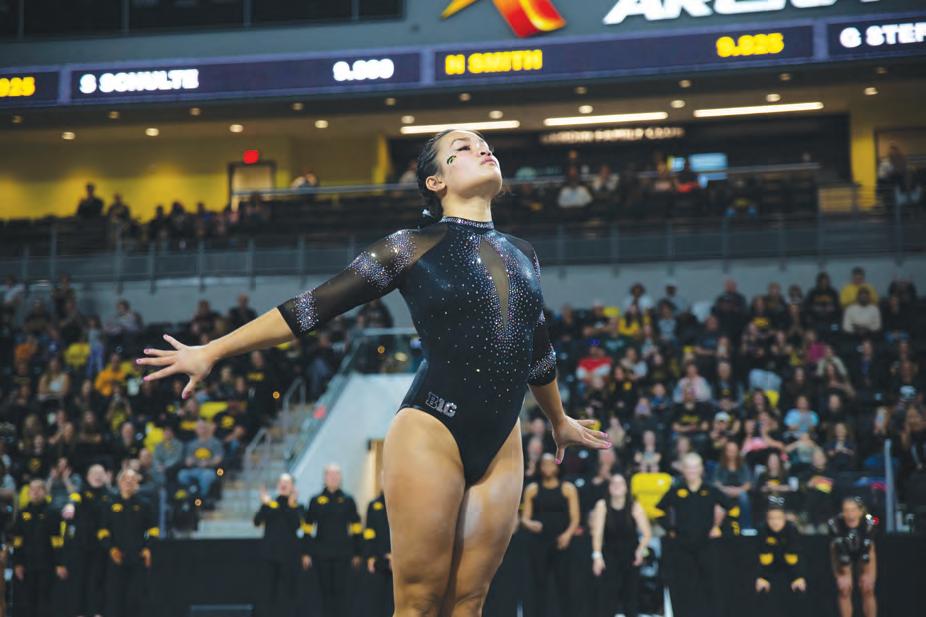
ferent styles, along with assistant coach Tonya Verbeek’s experience with the Canadian National Team, gives the Hawkeye women’s wrestlers a rounded coaching perspective throughout practice.

“They all bring different things to the table,” women’s wrestler Kylie Welker said of the coaching staff. “Coach Mayabb analyzes
Promising press
The Iowa men’s basketball team’s defensive press has been key to its recent success.
Jami Martin-Trainor Assistant Digital EditorDepending on the gym's culture, gymnastics can be a lonely sport.
When Iowa junior Adeline Kenlin was competing in club gymnastics, she understood this loneliness. Kenlin said she spent years practicing and competing alone throughout the elite growth process.
So, when Kenlin decided to pursue college gymnastics, she said she didn’t know how to adapt to having teammates.
“It was insanely weird, because I had 20 other girls on the team who all had my back, and I was supposed to have theirs right away,” Kenlin said. “It took a little bit of time.” After a few years with the
team, Kenlin is now known as the teammate who is constantly cheering on her peers and keeping morale up.
“She's constantly the example,” head coach Larissa Libby said. “She never stays on a down-swing. She always comes back into the gym and tries to put her best foot forward, even when she doesn't feel great.”
Although Kenlin has several teammates constantly looking up to her, she said she never feels any pressure.
Kenlin said she knows she is allowed to have bad days, and her team will always have her back.
“Honestly, it has helped me tremendously with my gymnastics,” Kenlin said.
“Whenever I'm having a bad day, one of the 20 people — if not more — knows how to come and cheer me up. It's
really amazing to have that support.”
In a sport where the risk of injury is high and the athletes are constantly rotating their entire bodies, maintaining mental fortitude is difficult.
Kenlin said she has overcome many injuries and has had to undergo surgery several times during her career.
“It's life and death every day,” Kenlin said. “I think that gymnasts have to be so mentally strong. Otherwise, they will not be able to do the sport anymore, and I've had to learn that.”
Even though Kenlin had garnered attention for her skills in gymnastics since she was a toddler, the Iowa City native said she knew she had to take a step back.
Iowa men’s basketball is experiencing a midseason defensive renaissance with an improved turnover differential, which is in turn driving the Hawkeyes to late-season success.

Since junior forward Patrick McCaffery’s return against Rutgers on Jan. 29 after missing six games because of anxiety, the Hawkeyes have won five of six games as of Feb. 18. Their sole loss came at the hands of then-No. 1 Purdue on the road.
During that six-game stretch, the Hawkeyes have forced 29 more turnovers than they’ve given up. The only game Iowa posted a turnover deficit during this stretch came in a 16-point victory over Northwestern on Jan. 31 when the Hawkeyes turned the ball over 12 times to the Wildcats’ 10.
Iowa has increased its forced turnovers by 2.5 takeaways per game compared to their rate during McCaffery’s absence. McCaffery himself has forced eight turnovers, including five steals in the Hawkeyes’ loss at Purdue.
To create turnovers, the Hawkeyes run a variety of press coverages to apply pressure to opponents’ guards as they bring the ball up the floor. The key to the Hawkeyes’ press defense is rangy forwards who move quickly laterally.
Iowa has two players on the roster who meet those requirements: McCaffery and fellow junior forward Kris Murray. At 6-foot9 and 6-foot-8, respectively, the two swing-
